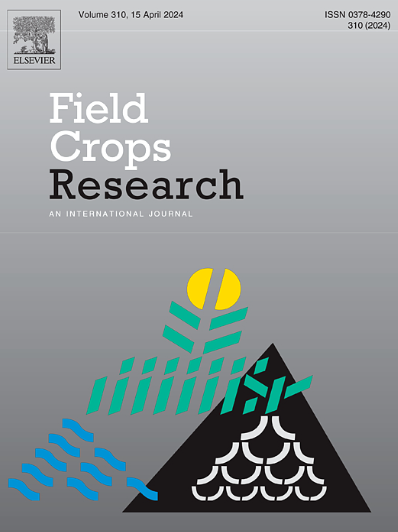长期间作调节丛枝菌根真菌群落结构,提高小麦产量
IF 5.6
1区 农林科学
Q1 AGRONOMY
引用次数: 0
摘要
长期连续的单一栽培导致频繁的种植障碍,严重限制了小麦生产。小麦和蚕豆的间作被认为是缓解这些挑战的有效策略,而间作对小麦产量的长期影响尚未探索。目的研究长期间作对小麦根际土壤理化性质、丛枝菌根真菌(AMF)群落组成和根系氮转运蛋白基因表达的影响,探讨其增效机制。方法通过田间试验,比较小麦单作(M)和小麦-蚕豆间作(I)两种种植模式2年和10年对小麦产量、土壤理化性质、AMF群落和根系氮转运基因表达的影响。结果与单作相比,间作可提高小麦产量,间作后10年产量最高。长期间作改善了小麦根际土壤结构,显著提高了土壤养分含量,提高了土壤肥力。增加AMF定殖能力、丰富度和多样性,调节AMF群落结构,促进小麦根系氮转运基因的表达,促进氮素吸收,最终提高产量。这些有益效果在长期间作后更为明显。结论长期小麦-蚕豆间作可改善土壤AMF群落组成,改善土壤理化性质,提高氮素转运效率,促进小麦生长,最终达到增产的目的。长期间作有助于促进可持续农业生产。本文章由计算机程序翻译,如有差异,请以英文原文为准。
Long-term intercropping regulates the community structure of arbuscular mycorrhizal fungi and improves wheat yield
Context
Long-term continuous monoculture has led to frequent cropping obstacles that significantly restrict wheat production. Intercropping of wheat and faba bean is considered an effective strategy to mitigate these challenges, whereas the long-term effects of intercropping on wheat yield remain unexplored.
Objective
This study aimed to assess the impact of long-term intercropping on wheat rhizosphere soil physicochemical properties, arbuscular mycorrhizal fungi (AMF) community composition, and root nitrogen transporter gene expression, with elucidating the synergistic mechanisms underlying yield enhancement.
Methods
A field experiment was conducted to compare two planting modes, wheat monocropping (M) and wheat-faba bean intercropping (I), over two durations (2 and 10 years) to examine their effects on wheat yield, soil physicochemical properties, AMF communities, and root nitrogen transporter gene expression.
Results
Intercropping increased wheat yield compared to monocropping, with the highest yield observed after 10 years of intercropping. Long-term intercropping improved wheat rhizosphere soil structure, significantly increased nutrient content, and enhanced soil fertility. It also increased AMF colonization ability, richness, and diversity, while regulating the AMF community structure, which promoted the expression of nitrogen transporter genes in wheat roots, improving nitrogen absorption, and ultimately boosting yield. These beneficial effects were more pronounced after long-term intercropping.
Conclusion
Long-term wheat-faba bean intercropping enhanced the AMF community composition, improved the soil physicochemical properties, enhanced the nitrogen transport efficiency, promoted wheat growth, and ultimately increased production.
Implications
Long-term intercropping contributes to promoting sustainable agricultural production.
求助全文
通过发布文献求助,成功后即可免费获取论文全文。
去求助
来源期刊

Field Crops Research
农林科学-农艺学
CiteScore
9.60
自引率
12.10%
发文量
307
审稿时长
46 days
期刊介绍:
Field Crops Research is an international journal publishing scientific articles on:
√ experimental and modelling research at field, farm and landscape levels
on temperate and tropical crops and cropping systems,
with a focus on crop ecology and physiology, agronomy, and plant genetics and breeding.
 求助内容:
求助内容: 应助结果提醒方式:
应助结果提醒方式:


